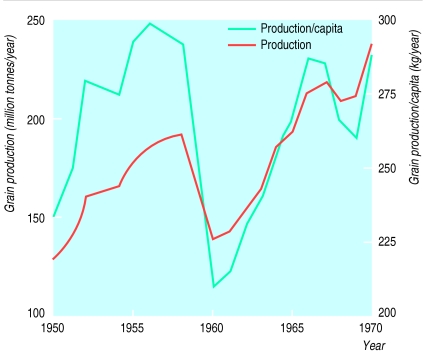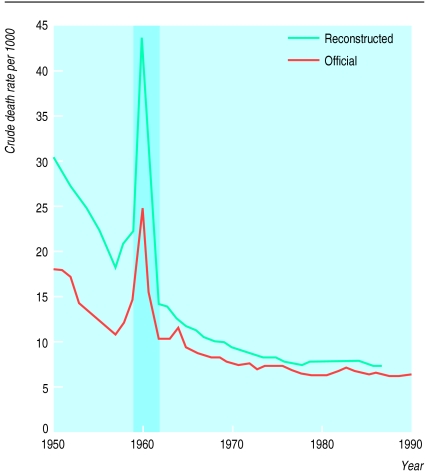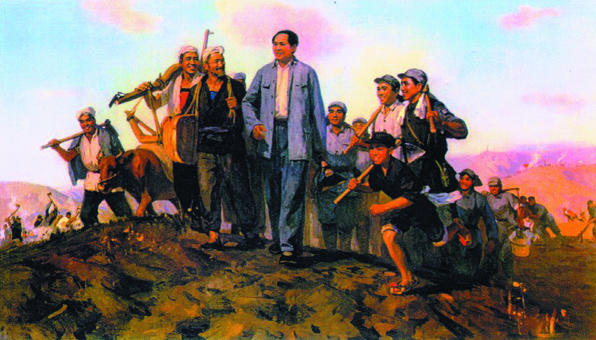Forty years ago China was in the middle of the world's largest famine: between the spring of 1959 and the end of 1961 some 30 million Chinese starved to death and about the same number of births were lost or postponed. The famine had overwhelmingly ideological causes, rating alongside the two world wars as a prime example of what Richard Rhodes labelled public manmade death, perhaps the most overlooked cause of 20th century mortality.1 Two generations later China, which has been rapidly modernising since the early 1980s, is economically successful and producing adequate amounts of food. Yet it has still not undertaken an open, critical examination of this unprecedented tragedy.
Summary points
The largest famine in human history took place in China during 1959-61
Although drought was a contributory factor, this was largely a manmade catastrophe for which Mao Zedong bears the greatest responsibility
We will never know the precise number of casualties, but the best demographic reconstructions indicate about 30 million dead
Two generations later China is yet to openly examine the causes and consequences of the famine
Origins of famine
The origins of the famine can be traced to Mao Zedong's decision, supported by the leadership of China's communist party, to launch the Great Leap Forward. This mass mobilisation of the country's huge population was to achieve in just a few years economic advances that took other nations many decades to accomplish.2 Mao, beholden to Stalinist ideology that stressed the key role of heavy industry, made steel production the centrepiece of this deluded effort. Instead of working in the fields, tens of millions of peasants were ordered to mine local deposits of iron ore and limestone, to cut trees for charcoal, to build simple clay furnaces, and to smelt metal. This frenzied enterprise did not produce steel but mostly lumps of brittle cast iron unfit for even simple tools. Peasants were forced to abandon all private food production, and newly formed agricultural communes planted less land to grain, which at that time was the source of more than 80% of China's food energy.3
At the same time, fabricated reports of record grain harvests were issued to demonstrate the superiority of communal farming. These gross exaggerations were then used to justify the expropriation of higher shares of grain for cities and the establishment of wasteful communal mess halls serving free meals.4 In reality, grain harvest plummeted (fig 1); and since supply and demand of food before 1958 were almost equal, by the spring of 1959 there was famine in a third of China's provinces.
Figure 1.
Total and per capita grain production in China, 1950-70
As an essentially social catastrophe, the famine showed clear marks of omission, commission, and provision. These three attributes recur in all modern manmade famines.5 The greatest omission was the failure of China's rulers to acknowledge the famine and promptly to secure foreign food aid. Study of famines shows how easily they can be ended (or prevented) once the government decides to act—but the Chinese government took nearly three years to act. Taking away all means of private food production (in some places even cooking utensils), forcing peasants into mismanaged communes, and continuing food exports were the worst acts of commission. Preferential supply of food to cities and to the ruling elite was the deliberate act of selective provision.
These actions are perfect illustrations of Sen's thesis about the critical link between political alienation of the governors from the governed: “The direct penalties of a famine are borne by one group of people and political decisions are taken by another. The rulers never starve. But when a government is accountable to the local populace it too has good reasons to do its best to eradicate famines. Democracy, via electoral politics, passes on the price of famines to the rulers as well.”6 There was no such link in Mao's China.
Weather only exacerbated the suffering. Official accounts still blame the natural catastrophes for the suffering—but China's own statistics belie this explanation.7 Undoubtedly, the drought of 1960-1 would have lowered grain supply in the worst affected provinces, but by itself it would have caused only a small fraction of the eventual nationwide death toll. During the 1990s the worst droughts and floods in China's modern history had only a marginal effect on the country's adequate food supply. Only a return to more rational economic policies after 1961, including imports of grain, ended the famine.
China's opening up to the world made a key difference. The first business deal signed after US President Nixon's visit to Beijing in 1972 was an order for 13 of the world's largest and most modern, American designed, nitrogen fertiliser plants. More purchases of such plants followed, and China became the world's largest producer of nitrogenous fertilisers. The first major change initiated by the reformist faction of the communist party in 1979, less than three years after Mao's death, was to dissolve agricultural communes and free farm prices. By 1984 all food rationing was lifted in the cities, and China's average per capita food supply rose to within 5% of Japan's comfortable mean.8
Extent of famine
The true extent of the famine was not revealed to the world until the publication of single year age distributions from the country's first highly reliable population census in 1982. These data made it possible to estimate the total number of excess deaths between 1959 and 1961, and the first calculations by American demographers put the toll at between 16.5 and 23 million.9 More detailed later studies came up with 23 to 30 million excess deaths, and unpublished Chinese materials hint at totals closer to 40 million.10–12 We will never know the actual toll because the official Chinese figures for the three famine years greatly underestimate both the fall in fertility and the rise in mortality and because we cannot accurately reconstruct these vital statistics (fig 2).
Figure 2.
Officially reported and reconstructed mortality in China, 1950-90 (famine period is shaded)
The lack of accuracy is as expected. All death tolls cited for major famines have large margins of error. This is true even for events unfolding amid unprecedented publicity. An attempt to discern a coherent picture of morbidity, mortality, and nutritional status during the 1991-2 famine in Somalia, an effort based on 23 separate field studies, ended in failure.13 Similar controversies surround the recent estimates of the excess deaths in Iraq attributable to economic sanctions after the Gulf war.14
Need for open discussion
But no amount of additional information and no new and more sophisticated demographic analyses can change the fundamental conclusion: Mao's delusionary policies caused by far the largest famine in human history. Yet in contrast to other great famines of the 20th century (Ukraine 1932-3, Bengal 1943-4), the causes of the Chinese famine and an attribution of responsibility for its depth and duration have never been openly discussed in the afflicted nation. Beyond a narrow circle of China experts, the famine has also been virtually ignored by Western scholars and politicians. The need for moral examination and historical closure is obvious. Eventually the country will have to examine the causes and consequences of the tragedy whose magnitude surpasses the combined toll of all other famines China has experienced during the past two centuries.
How could this famine have lasted so long? How tenable is it to excuse the actions of so many people throughout the party and state bureaucracy by blaming solely their leader? Had they no other choice but to follow orders and to carry out, often against resistance, mindless collectivisation and reduced planting of grain, to falsify harvest statistics, and to forcibly take grain away from evidently starving peasants? Germany has spent two generations trying to understand the horrors of the Third Reich and to atone for its transgressions. Russia began to face its dark past soon after Stalin's death, when Khrushchev opened the gates of the Gulag and had the dictator's embalmed corpse removed from the Red Square mausoleum. China's turn is yet to come.
If, as is likely, such an accounting does not happen soon, the direct memories of survivors will be lost. Of course, the archives of the Chinese communist party and of its enormous secret police apparatus will eventually be opened and yield—much like the party and KGB archives in Russia since 1991—some of their long hidden secrets. Many facts we will never know. A leading Chinese demographer found that even casual surveys of villages in areas that experienced the worst starvation show an unusually high extent of mental impairment among adults born during the famine years (X Peng, personal communication). Given the importance of nutrition for the development of mental capacities during infancy and early childhood this was a predictable tragedy.15 We will never know how many millions of survivors throughout China have had their lives twisted in this terrible way.
Finally, what are we to make of the Western indifference to the great famine? Eyewitness stories of refugees who fled to Hong Kong were widely dismissed and rarely reported during the famine years. Two generations later a journalistic account is the only fairly comprehensive volume on the famine published in the West.16 Incredibly, the 1997 edition of the New Encyclopaedia Britannica does not even list the catastrophe in its tabulation of famines of the past 200 years.17 An in depth scholarly history of the famine has yet to be written.
Figure.
Peasants were forced to abandon private food production
Footnotes
Competing interest: None declared.
References
- 1.Rhodes R. Man-made death: a neglected mortality. JAMA. 1988;260:686–687. [PubMed] [Google Scholar]
- 2.Yang D. Catastrophe and reform in China. Stanford: Stanford University Press; 1996. [Google Scholar]
- 3.Smil V. China's food: availability, requirements, composition, prospects. Food Policy. 1981;6:67–77. [Google Scholar]
- 4.Chang GH, Wen GJ. Communal dining and the Chinese famine of 1958-1961. Econ Dev Cult Change. 1997;46:1–34. [Google Scholar]
- 5.Macrae J, Zwi A. London: Zed Books; 1994. Famine, complex emergencies and international policy in Africa: an overview. In: War and hunger; pp. 6–36. [Google Scholar]
- 6.Sen A. Nobody need starve. Granta. 1995;52:217. [Google Scholar]
- 7.State Statistical Bureau. China statistical yearbook. Beijing: State Statistical Bureau; 1978-98. [Google Scholar]
- 8.Smil V. China's food. Sci Am. 1985;253(6):116–124. [Google Scholar]
- 9.Aird J. Population studies and population policy in China. Popul Dev Rev. 1982;8:85–97. [Google Scholar]
- 10.Ashton B, Hill K, Piazza A, Zeitz R. Famine in China, 1958-61. Popul Dev Rev. 1984;10:613–645. [Google Scholar]
- 11.Peng X. Demographic consequences of the Great Leap Forward in China's provinces. Popul Dev Rev. 1987;13:639–670. [Google Scholar]
- 12.Banister J. China's changing population. Stanford: Stanford University Press; 1987. [Google Scholar]
- 13.Boss LP, Toole MJ, Yip R. Assessments of mortality, morbidity, and nutritional status in Somalia during the 1991-1992 famine. JAMA. 1994;272:371–376. [PubMed] [Google Scholar]
- 14.Lopez GA, Cortright D. Pain and promises. Bull Atom Sci. 1998;54:39–43. [Google Scholar]
- 15.Pollitt E, editor. The relationship between undernutrition and behavioral development in children. J Nutrition. 1995;125(suppl 8):2211–284S. [PubMed] [Google Scholar]
- 16.Becker J. Hungry ghosts. New York: Free Press; 1996. [Google Scholar]
- 17.Encyclopaedia Britannica. New encyclopaedia britannica micropedia. Vol. 4. Chicago: Encyclopaedia Britannica; 1997. pp. 674–675. [Google Scholar]





